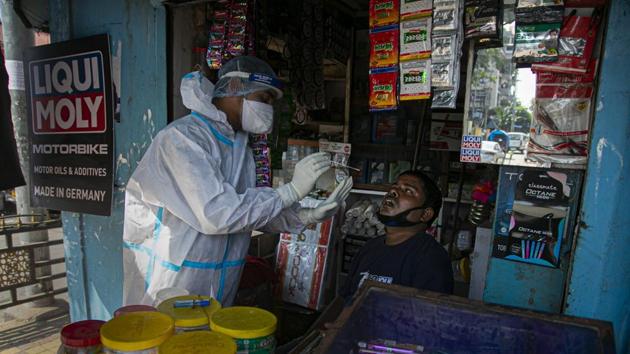Covid-19: What you need to know today
Only the US (around 122 million) and China (160 million) have done more tests than India. Even in terms of tests per million, at 100 million tests, India has conducted around 77,000 tests per million of the population.
India completed its 100 millionth test for Covid sometime on Friday, according to the HT dashboard. By the Indian Council of Medical Research’s count, the number was marginally lower, 92.25 million tests (ICMR has a counting protocol that isn’t followed by all states), which means that the 100-million mark will be crossed in a week, maybe sooner.

Still, I’m going to stick with the 100-million-on-Friday mark because the test numbers on the HT dashboard are the ones we use for measuring the positivity rate.
Only the US (around 122 million) and China (160 million) have done more tests than India. Even in terms of tests per million, at 100 million tests, India has conducted around 77,000 tests per million of the population. That translates into 7.7% of the population — adequate according to most experts if the trace-isolate-treat protocol that follows the tests is stringent enough. Unfortunately, it rarely is, not just in India, but in most parts of the world.
Also Read| Covid: Daily RT-PCR tests touch record 15,000-mark, cases above 3,000 in Delhi
The 100 million number also includes retests. And it includes not just molecular tests such as the reverse transcription polymerase chain reaction (RT-PCR) tests but also rapid antigen tests (RATs). I’ve written extensively about the indiscriminate use of the latter, in contexts in which it doesn’t make sense for them to be used, and in huge numbers (especially in Bihar and Uttar Pradesh where they account for most of the tests conducted; even Delhi uses far too many rapid tests for its own good — and for the good of its people). Still, 100 million is 100 million, and for a country that started with the capacity of a few laboratories and a few thousand tests in late February and March, the number marks a tremendous achievement.
India, as Dispatch 176 on October 7 pointed out first, has seen off the first wave and is in the lull between that and the sure-to-come second wave. Given this, and the testing milestone, how are Indian states doing?
The table accompanying this piece lists 11 states that together account for 79% of India’s cases, 82% of its tests and 70% of its tests as of Thursday evening. Sure, 10 is a better number but I picked 11 because Bihar is the 11th on the list in terms of number of cases and its numbers are interesting.

Of the 11, Bihar and Uttar Pradesh have the lowest positivity rates — the number of people testing positive to tests conducted, 2.3% and 3.6%, respectively. The average of these 11 states is 8.3%, a number skewed upward by Maharashtra’s high case number and positivity rate. The national average is 7.4% (according to the HT dashboard).
Interestingly, if the case fatality rate is a proxy of the quality of a state’s health system — it should be — then Bihar, Kerala, Odisha and Telangana are more similar than most people would expect. Kerala has the lowest case fatality rate of 0.34%; Odisha’s is 0.43%; Bihar’s is 0.48%; and Telangana’s 0.57%. The only other state among the 11 with a case fatality rate lower than 1% is Telangana. The case fatality rate of these 11 states is 1.56%, marginally higher than India’s 1.52%. Uttar Pradesh’s case fatality rate, at 1.46%, is actually lower than the national number.
It’s difficult to explain Uttar Pradesh and Bihar’s low positivity rate (and we won’t try to). There might be a possible explanation for the low case fatality rates in Kerala because the state does have an excellent public health system. And there might be a possible explanation for the low case fatality rates in Bihar because the infections started showing up in the state well after they did in many others, and both nationally and internationally, health care systems have become better at saving lives as the pandemic has progressed. Does that explain rates as low as 0.34% and 0.48%? Uttar Pradesh’s numbers are at least internally consistent — it has few cases, but the proportion of deaths is almost the same as the national number.
Just like the mystery surrounding Africa’s numbers — I wrote about this in Dispatch 154 on September 10 — that surrounding Uttar Pradesh and Bihar’s extremely low positivity rate and Bihar’s low case fatality rate need studying, for it could hold answers on managing the pandemic.
Get Current Updates on India News, Lok Sabha Election 2024 LIVE, Solar Eclipse 2024 Live, Election 2024 along with Latest News and Top Headlines from India and around the world.




